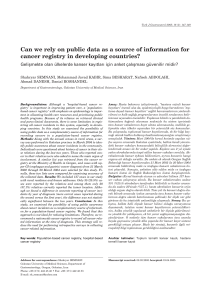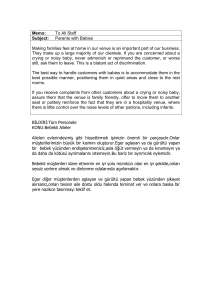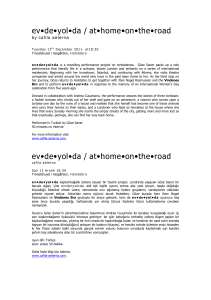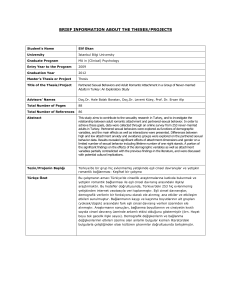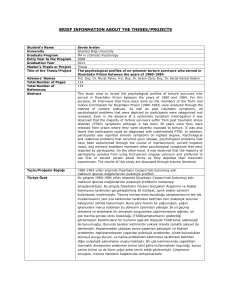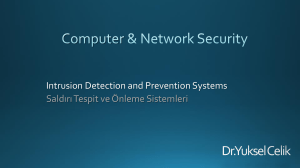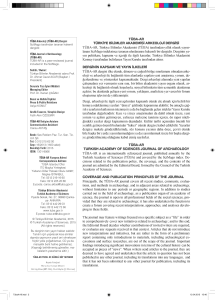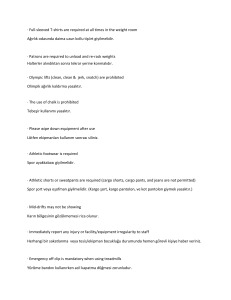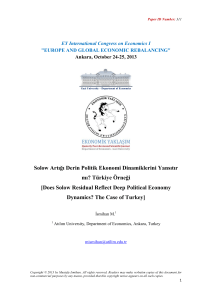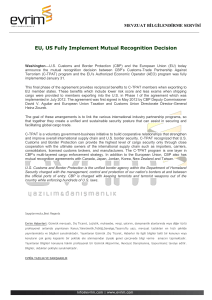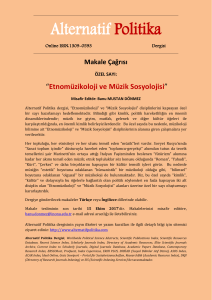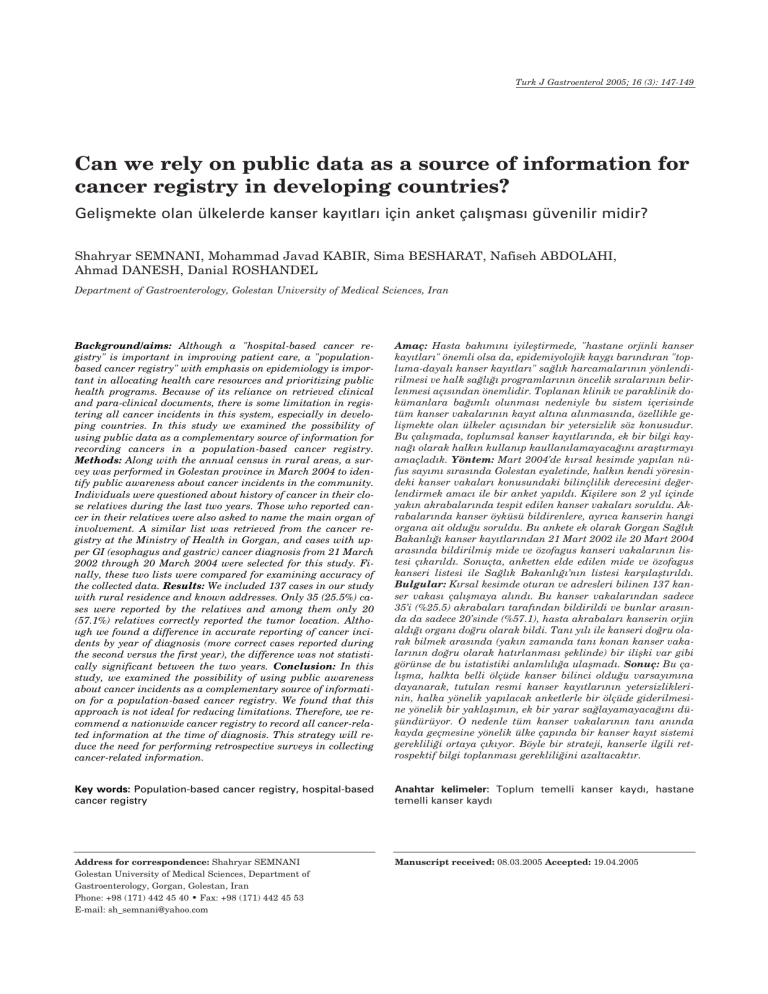
Turk J Gastroenterol 2005; 16 (3): 147-149
Can we rely on public data as a source of information for
cancer registry in developing countries?
Geliflmekte olan ülkelerde kanser kay›tlar› için anket çal›flmas› güvenilir midir?
Shahryar SEMNANI, Mohammad Javad KABIR, Sima BESHARAT, Nafiseh ABDOLAHI,
Ahmad DANESH, Danial ROSHANDEL
Department of Gastroenterology, Golestan University of Medical Sciences, Iran
Background/aims: Although a "hospital-based cancer registry" is important in improving patient care, a "populationbased cancer registry" with emphasis on epidemiology is important in allocating health care resources and prioritizing public
health programs. Because of its reliance on retrieved clinical
and para-clinical documents, there is some limitation in registering all cancer incidents in this system, especially in developing countries. In this study we examined the possibility of
using public data as a complementary source of information for
recording cancers in a population-based cancer registry.
Methods: Along with the annual census in rural areas, a survey was performed in Golestan province in March 2004 to identify public awareness about cancer incidents in the community.
Individuals were questioned about history of cancer in their close relatives during the last two years. Those who reported cancer in their relatives were also asked to name the main organ of
involvement. A similar list was retrieved from the cancer registry at the Ministry of Health in Gorgan, and cases with upper GI (esophagus and gastric) cancer diagnosis from 21 March
2002 through 20 March 2004 were selected for this study. Finally, these two lists were compared for examining accuracy of
the collected data. Results: We included 137 cases in our study
with rural residence and known addresses. Only 35 (25.5%) cases were reported by the relatives and among them only 20
(57.1%) relatives correctly reported the tumor location. Although we found a difference in accurate reporting of cancer incidents by year of diagnosis (more correct cases reported during
the second versus the first year), the difference was not statistically significant between the two years. Conclusion: In this
study, we examined the possibility of using public awareness
about cancer incidents as a complementary source of information for a population-based cancer registry. We found that this
approach is not ideal for reducing limitations. Therefore, we recommend a nationwide cancer registry to record all cancer-related information at the time of diagnosis. This strategy will reduce the need for performing retrospective surveys in collecting
cancer-related information.
Amaç: Hasta bak›m›n› iyilefltirmede, "hastane orjinli kanser
kay›tlar›" önemli olsa da, epidemiyolojik kayg› bar›nd›ran "topluma-dayal› kanser kay›tlar›" sa¤l›k harcamalar›n›n yönlendirilmesi ve halk sa¤l›¤› programlar›n›n öncelik s›ralar›n›n belirlenmesi aç›s›ndan önemlidir. Toplanan klinik ve paraklinik dokümanlara ba¤›ml› olunmas› nedeniyle bu sistem içerisinde
tüm kanser vakalar›n›n kay›t alt›na al›nmas›nda, özellikle geliflmekte olan ülkeler aç›s›ndan bir yetersizlik söz konusudur.
Bu çal›flmada, toplumsal kanser kay›tlar›nda, ek bir bilgi kayna¤› olarak halk›n kullan›p kaullan›lamayaca¤›n› araflt›rmay›
amaçlad›k. Yöntem: Mart 2004’de k›rsal kesimde yap›lan nüfus say›m› s›ras›nda Golestan eyaletinde, halk›n kendi yöresindeki kanser vakalar› konusundaki bilinçlilik derecesini de¤erlendirmek amac› ile bir anket yap›ld›. Kiflilere son 2 y›l içinde
yak›n akrabalar›nda tespit edilen kanser vakalar› soruldu. Akrabalar›nda kanser öyküsü bildirenlere, ayr›ca kanserin hangi
organa ait oldu¤u soruldu. Bu ankete ek olarak Gorgan Sa¤l›k
Bakanl›¤› kanser kay›tlar›ndan 21 Mart 2002 ile 20 Mart 2004
aras›nda bildirilmifl mide ve özofagus kanseri vakalar›n›n listesi ç›kar›ld›. Sonuçta, anketten elde edilen mide ve özofagus
kanseri listesi ile Sa¤l›k Bakanl›¤›’n›n listesi karfl›laflt›r›ld›.
Bulgular: K›rsal kesimde oturan ve adresleri bilinen 137 kanser vakas› çal›flmaya al›nd›. Bu kanser vakalar›ndan sadece
35’i (%25.5) akrabalar› taraf›ndan bildirildi ve bunlar aras›nda da sadece 20’sinde (%57.1), hasta akrabalar› kanserin orjin
ald›¤› organ› do¤ru olarak bildi. Tan› y›l› ile kanseri do¤ru olarak bilmek aras›nda (yak›n zamanda tan› konan kanser vakalar›n›n do¤ru olarak hat›rlanmas› fleklinde) bir iliflki var gibi
görünse de bu istatistiki anlaml›l›¤a ulaflmad›. Sonuç: Bu çal›flma, halkta belli ölçüde kanser bilinci oldu¤u varsay›m›na
dayanarak, tutulan resmi kanser kay›tlar›n›n yetersizliklerinin, halka yönelik yap›lacak anketlerle bir ölçüde giderilmesine yönelik bir yaklafl›m›n, ek bir yarar sa¤layamayaca¤›n› düflündürüyor. O nedenle tüm kanser vakalar›n›n tan› an›nda
kayda geçmesine yönelik ülke çap›nda bir kanser kay›t sistemi
gereklili¤i ortaya ç›k›yor. Böyle bir strateji, kanserle ilgili retrospektif bilgi toplanmas› gereklili¤ini azaltacakt›r.
Key words: Population-based cancer registry, hospital-based
cancer registry
Anahtar kelimeler: Toplum temelli kanser kayd›, hastane
temelli kanser kayd›
Address for correspondence: Shahryar SEMNANI
Golestan University of Medical Sciences, Department of
Gastroenterology, Gorgan, Golestan, Iran
Phone: +98 (171) 442 45 40 • Fax: +98 (171) 442 45 53
E-mail: [email protected]
Manuscript received: 08.03.2005 Accepted: 19.04.2005
148
INTRODUCTION
Cancer registry is one of the main sources for cancer studies (1, 2). In general, there are two types of
cancer registries: "population-based cancer registry" and "hospital-based cancer registry". Based on the purpose of establishing cancer registry,
each of these methods has a specific design for collecting and capturing cancer-related information.
The most common method currently being used in
Iran is "pathology-based cancer registry", in which
all cancers are recorded based on collected pathology reports from hospitals and pathology centers.
The main shortcoming of this method is lack of information about cases with clinical or para-clinical
(e.g., X-ray, CT scan, or sonography) diagnosis.
Pathologic evaluations are not performed on these
patients and treatment centers or physician offices do not report these cases to the cancer registries. A new technique with the capacity to take into account clinically and para-clinically diagnosed
cancers in cancer registries is needed to overcome
this limitation.
Golestan province set up its first cancer registry
eight years ago and it is now planning to establish
a population-based cancer registry, which is a
comprehensive method and has the required capacity to capture more cancer cases (3). In this method, information regarding possible cancers (clinical or para-clinical documents) in addition to pathology reports from confirmed cases is collected,
and, after a thorough evaluation, cases with possible cancer diagnosis are registered at the cancer
registry.
Although it has a broader range of investigation in
registering cancers, low quality and quantity of
retrieved clinical and para-clinical documents may
lessen its comprehensiveness in recording all cancer incidents (4, 5). Regarding the importance of
capturing all cancers in the cancer registry and lowering the possibility of missing cases with clinical or para-clinical diagnosis (6), such as those
who are diagnosed at other provinces, we examined the possibility of using public awareness about cancer in the community as a complementary
source of information for cancer registry. It is based on the hypothesis that some cancers are not
diagnosed pathologically and the clinical or paraclinical documents may not be retrieved for these
cancers by the cancer registry.
In this report, we tried to compare information regarding recorded cancers at the Ministry of Health
SEMNANI et al.
in Gorgan with public awareness about cancer incidents in the community. If this study shows that
there are unreported cancers in rural communities and relatives are aware of them, we might recommend public data as a complementary source
of information for a population-based cancer registry. We chose rural residents because they are
more oriented about their community and have
stronger social cohesion than urban residents.
MATERIALS AND METHODS
During the annual rural census in March 2004, an
open questionnaire was attached to the official
census forms and all residents were asked to report occurrence of cancer during the last five years
in their close relatives. If such a case existed, they
were asked to locate the tumor by naming the involved organ. For the purpose of this study, we
retrieved esophageal and gastric cancers recorded
in the pathology-based cancer registry at the Ministry of Health in Gorgan from 21 March 2002
through 20 March 2004; only rural residents with
precise address were included in this study. We
then checked this information with the data collected from rural residents. Chi-square test was used
for statistical comparison of accuracy of collected
data with the year of registration (first year versus second year). P value of 0.05 was accepted to
indicate level of significance. The required early
measures were taken to keep patient medical information confidential. The Ethical Committee of
Golestan University of Medical Sciences (GOUMS) approved the study.
RESULTS
Based on the collected pathology reports, a total of
217 esophageal and gastric cancers were registered in the cancer registry at the Ministry of Health in Gorgan during the two-year study period.
After excluding urban residents and cases with
unknown address, we investigated 137 cases to
compare their information with the data collected
from rural residents. Table 1 shows patients’ demographic and clinicopathologic factors retrieved
from the cancer registry.
A total of 137 esophageal and gastric cancers were registered during the two-year study period at
the Ministry of Health, but relatives reported only
35 (25.5%) of these. Among reported cases, only 20
relatives correctly reported tumor location, which
was matched with our roster from the Ministry of
Health. Other tumor locations (15 cases) that we-
149
Public data for cancer registry
Table 1. Patients’ demographic and clinicopathologic
factors
Factors
Esophageal
cancer (%)
Year of
2002-2003
37.3
diagnosis
2003-2004
62.7
Mean age (SD)
65.69 (12.36)
Sex
Male
57.3
Female
42.7
Tumor histology SCC
69.1
Adenocarcinoma
10.0
Unknown
20.9
Gastric
cancer (%)
37
63
62.59 (11.31)
81.5
18.5
0.0
85.2
14.8
re incorrectly reported by the relatives were breast, lung, large bowel, and blood cancer.
There was no difference in accuracy of reporting
(correct or false report) based on sex and age of the
deceased person. Although relatives reported diagnosed cases in the first year with a better accuracy than in the second year (53.3% versus 46.7%),
this difference was not statistically significant
(p>0.05).
DISCUSSION
Regarding the importance of cancer registry and
the need for improving recorded cancers in the population-based cancer registry, we examined the
possibility of using public awareness about cancer
among relatives as a complementary source of information for registering cancers. Results from
this study revealed that collected information
from relatives, even close relatives, is not a reliable source of information for cancer registry. This is
more appreciated when we consider the collection
of information from several years ago. Although
we did not find a significant difference between years of diagnosis, in a larger sample size and longer
retrospective study we may better appreciate this
fact. This finding is in contrast with previous studies (7), which may highlight the unreliability of
collected information in developing countries. This
may also raise uncertainties about the accuracy of
family history in the clinical setting. Therefore, it
may be logical to perform similar studies to explore this possibility.
There is much work to be done regarding cancer
registry in Golestan province and it may take several years before it is fully established (8). Since
the Golestan province has been selected for a pilot
study in cancer registry, it is prudent to set a network at the province level to systematically collect
all relevant information from private or public medical centers. Recording confirmed or suspicious
cancer cases on pre-designed cancer registry forms
at the time of diagnosis and/or clinical evaluation
would be a complementary approach for capturing
cancer cases. In this way, there would be no need
to perform a retrospective study, and the collected
information could be shared with other cancer registries at the national level to record cancer-related information.
REFERENCES
1. Fujimoto I, Hanai A, Tsukuma H, et al. Role of populationbased cancer registry in cancer epidemiology--epidemiological studies in the cancer registration scheme in Osaka,
Japan. Nippon Eiseigaku Zasshi 1994; 49(2): 543-58.
2. Bouvier AM, Dancourt V, Faivre J. The role of cancer registries in the surveillance, epidemiologic research and disease prevention. Bull Cancer 2003; 90(10): 865-71.
3. Rostgaard K, Holst H, Mouridsen H T, et al.Do clinical databases render population-based cancer registries obsolete?
The example of breast cancer in Denmark. Cancer Causes
Control 2000; 11: 669-74.
4. Malin JL, Kahn KL, Adams J, et al. Validity of cancer registry data for measuring the quality of breast cancer care.
J Natl Cancer Inst 2002; 94: 835-44.
5. Teppo L, Pukkala E, Lehtonen M. Data quality and quality
control of a population-based cancer registry. Experience in
Finland. Acta Oncol 1994; 33(4): 365-9.
6. Lang K, Magi M, Aareleid T. Study of completeness of registration at the Estonian cancer registry. Eur J Cancer
Prev 2003; 12(2): 153-6.
7. Verkooijen HM, Fioretta G, Chappuis PO, et al. Set-up of a
population-based familial breast cancer registry in Geneva,
Switzerland: validation of first results. Ann Oncol 2004; 15:
350-3.
8. Schuz J, Schon D, Batzler W, et al. Cancer registration in
Germany: current status, perspectives and trends in cancer
incidence 1973-93. J Epidemiol Biostat 2000; 5(2): 99-107.

